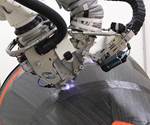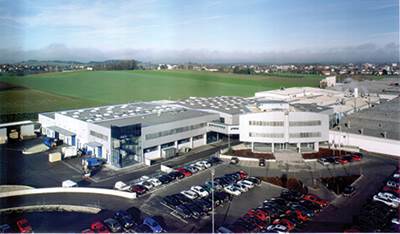Resin infusion: Taking off?
Boeing Aerostructures Australia leads large-scale development of resin infusion as an industrial process.
Resin infusion is not yet widely used in aerospace applications, but where it is, it provides great economic advantage on highly loaded, critical components. Premium Aerotec (Augsburg, Germany) is producing the rear pressure bulkheads for The Boeing Co.’s (Chicago, IL., US) 787 Dreamliner and the Airbus (Toulouse, France) A350 XWB, and is using the Airbus-patented Vacuum Assisted Process (VAP) to build the Airbus A400M cargo door. A similar process has been demonstrated by FACC (Ried im Innkreis, Austria) in the DAEDALUS program for an integrated A350 spoiler, and one is being certified by Aerocomposit (Moscow, Russia) for the wing and wingbox of the Irkut (Moscow, Russia) MS-21 single-aisle jet (for more on all, see “Resin-infused MS-21 winds and wingbox" under "Editor's Picks" at top right). The Mitsubishi Regional Jet (MRJ) program also has developed the advanced vacuum-assisted resin transfer molding (A-VaRTM) process for the aircraft’s vertical tail, citing not only productivity improvements but also weight reduction in primary structures. Specifically, dry fabrics are said to be easier to fit into 3D geometries with ply drop-offs, reducing the risk of wrinkles commonly seen with prepreg. Proponents of A-VaRTM and several other liquid molding processes are developing a hot compaction process step to densify the preform while shaping it and melting any thermoplastic binder in the dry fabrics to achieve fiber volume fractions on par with conventional prepreg processing.
Boeing Aerostructures Australia (BAA, previously Hawker de Havilland, Melbourne, Victoria) produces the only other resin-infused structure currently flying on a commercial aircraft, the movable trailing edge (MTE) on the Boeing 787. The MTE is actually an assortment of separately molded parts that includes the aileron, flaperon, inboard and outboard flaps, seven spoilers and all of the fairings. The largest of these parts is the 10m-long by 4m-wide outboard flap.
A Boeing subsidiary since 2000, BAA began collaborating with the Australian government-funded Cooperative Research Centre for Advanced Composite Structures (CRC-ACS, Melbourne) in the 1990s to modify the marine industry’s VARTM process for aerospace use. Central to its 2003 win of the US$5 billion, 20-year, sole-supplier contract for the B787 MTE, the public/private research effort demonstrated full-scale, resin-infused structures that meet aerospace-quality requirements while integrating multiple components into single, unitized parts, thus reducing assembly labor, time and cost. Computer modeling and process simulation enabled designers to address production issues early and reduce testing, resulting in significant cost savings.
In 2008, Boeing invested further in infusion by establishing its largest R&D facility outside the US in Port Melbourne, Victoria. Boeing Research and Technology – Australia (BR&T-A) now focuses on resin infusion and advanced robotics and automation. “Resin infusion technology enables use of lower cost materials ... without the need for expensive autoclaves,” said David Pook, Melbourne Tech Centre manager for BR&T-Australia.
Using Hexcel’s (Stamford, CT, US) HexRTM6 epoxy resin and a specially developed HexForce 12K spread-tow carbon fiber fabric, BAA uses a modified form of VARTM, Boeing’s patented Controlled Atmospheric Pressure Resin Infusion (CAPRI). This reportedly resolves the lack of compaction pressure on the preform after resin infiltration by placing the resin reservoir under partial vacuum so that its pressure is below 1 atm. Boeing has used CAPRI to demonstrate parts with fiber volume fractions and performance equivalent to autoclave-cured prepreg parts. CAPRI also has been used in conjunction with stitched preforms to make landing gear doors for the C-17 Globemaster III transport aircraft for the US Air Force.
BAA cures MTE parts in 15 large ovens supplied by Furnace Engineering (Victoria) which provide air recirculation rates and heating power to match an autoclave’s efficiency in delivering heat to both the tool and part, while still reducing the overall process cost. “At first glance, the fans on these aerospace infusion ovens may seem disproportionately large for the oven,” says Furnace Engineering director Brian Gooden, but he explains, “This is in order to ensure rapid but uniform heat-up rates are achieved.”
BAA currently ships 10 MTE sets per month to the B787 final assembly line, and aims for 12 per month by 2016 and 14 per month by 2020. It will continue working hand-in-hand with BR&T-A to develop the next generation of resin-infused composites to meet targets for improved performance, rapid processing and reduced environmental impact.
Related Content
Materials & Processes: Fabrication methods
There are numerous methods for fabricating composite components. Selection of a method for a particular part, therefore, will depend on the materials, the part design and end-use or application. Here's a guide to selection.
Read MoreNovel dry tape for liquid molded composites
MTorres seeks to enable next-gen aircraft and open new markets for composites with low-cost, high-permeability tapes and versatile, high-speed production lines.
Read MoreThe state of recycled carbon fiber
As the need for carbon fiber rises, can recycling fill the gap?
Read MoreMaterials & Processes: Resin matrices for composites
The matrix binds the fiber reinforcement, gives the composite component its shape and determines its surface quality. A composite matrix may be a polymer, ceramic, metal or carbon. Here’s a guide to selection.
Read MoreRead Next
Dry fiber placement: Surpassing limits
Coriolis Composites’ automated aerostructures manufacturing using dry materials moves from development projects to production.
Read MoreFACC AG: Aerocomposites Powerhouse
This pragmatic Austria-based innovator is pursuing lofty goals in an aerocomposites future full of opportunity.
Read More
























